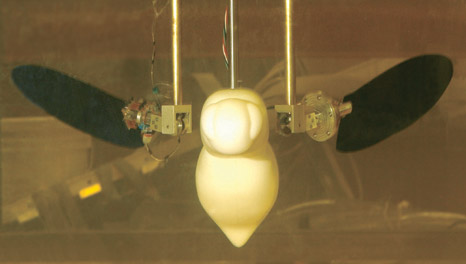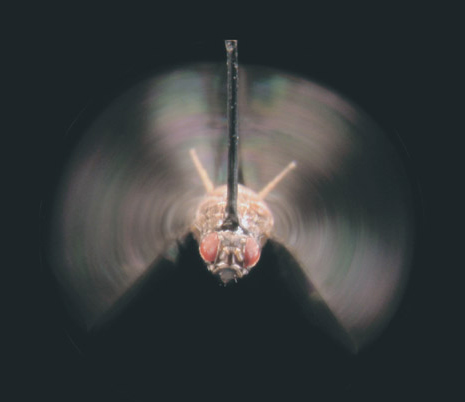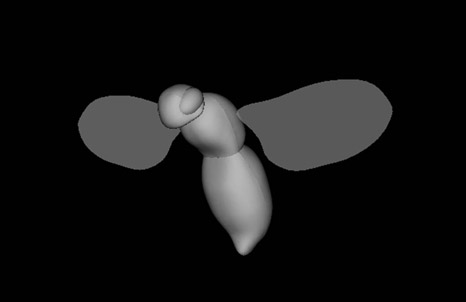 |
|
|||
Click here to view all Upcoming Events// IFF Directors Talks
IFF Directors Talks 2012 // Previous IFF Lectures THE MOSELY SNOWFLAKE SPONGE THE ART OF ITERATION MAKING SPACE IFF Director Margaret Wertheim speaks at Art Center College of Design Captain Charles Moore Talks About Plastic Trash IFF Director Margaret Wertheim Seeing Anew [IFF-L20] Structural Considerations of the Business Card
Sponge[IFF-L17] Where the Wild Things Are 2: Things That Think: Where the Wild Things Are: Crocheting the Hyperbolic Plane: Darwinism on a Desktop: The Logic Alphabet Why Things Don't Fall Down Kindergarten: Crocheting the Hyperbolic Plane [IFF-L5] The Mathematics of Paper Folding [IFF-L4] The Physics of Snowflakes [IFF-L3] Crocheting the Hyperbolic Plane [IFF-L2] The Figure That Stands Behind Figures: // Previous Events Crochet Hyperbolic Workshop
|
The
Institute for Figuring |
|||
 |
||||
| "Robofly"
- a robotic mechanism whose wings can be changed to simulate the flight of a fruit fly, a hummingbird, or a honeybee. |
||||
| In
a two-ton vat of mineral oil a set of robotic wings beat silently.
Nearby, in a circular corral of computer controlled LED’s,
a fly tethered by a tungsten wire beats its own organic wings hundreds
of times a second. As the animal flaps, laser-based sensors measure
the force and torque of its miniature movements while a “wing
beat analyzer” tracks the shadows of its gossamer foils. Elsewhere
in the lab of Dr Michael Dickinson, researchers use stereoscopic
video to reconstruct the insects’ flight path and to simulate
a “fly’s eye view” of the world. Where the French
oceanographer Jean Painleve took us inside the world of the octopus
and seahorse, so Dickinson takes us into the realm of the fruit
fly. |
||||
 |
||||
A
fruit fly tethered by a tungsten wire enables scientists to study
the force and torque on its miniature wings. Photos courtesy of Dr. Michael Dickinson, California Institute of Technology. |
||||
|
360 million years before the Wright brothers pitched
a glider into the wind, the descendents of shrimp-like crustaceans
learned the art of hovering - a skill that humans have yet to finesse.
Just as crustaceans swim by furiously beating their legs, so insects
fly by furiously beating their wings, a hyperactive expenditure
of energy that is at once efficient and amazingly effective. Insects’
aerobatic maneuverings are the envy of engineers and now the subject
of intensive scientific research. In this talk Dr Michael Dickinson
will discuss the aerodynamics, physiology, and perceptual systems
involved in a flies’ flight. The event will include unique
high-speed films and animations of how a fly experiences the world. |
||||
 |
||||
|
In a computer simulation a virtual
fly helps scientists decipher the complex aerodynamics of insect
flight. Unlike airplanes, which always aim for stability, insects
wings operate at the edge of instability and they are constantly
on the verge of stalling. |
||||
|
Dr Michael Dickinson’s laboratory
at Caltech is devoted to understanding “the motion of a fly
through the air.” Trained as a classical zoologist, Dickinson
has also studied the physiology of hummingbird flight and is researching
the control mechanisms underlying a wide class of insect gaits.
He is the architect of the Grand Unified Fly project that aims “to
encode in silicon as much of a fly as we can." THE INSECT TRILOGY #1 How Flies Fly – Dr. Michael Dickinson (Thurs, May 4) #2 The Ecology of a Termite's Gut – Dr. Jared Leadbetter (Thurs, June 1) #3 What is it Like to be a Spider – Dr. Simon Pollard (Wed, June 28) The Institute For Figuring is a nonprofit organization devoted to enhancing the public understanding of figures and figuring techniques. This lecture series is hosted by Telic Arts Exchange and funded in part by a grant from the Annenberg Foundation. |
||||
| © 2003–2018 The Institute For Figuring | ||||